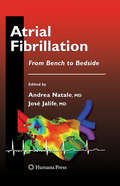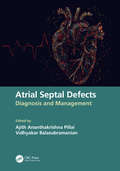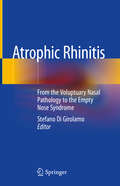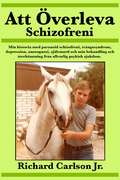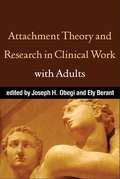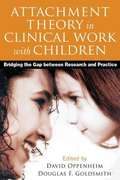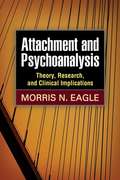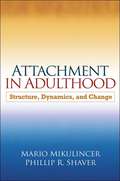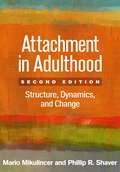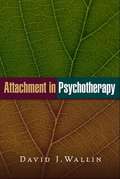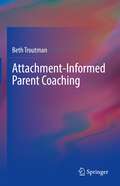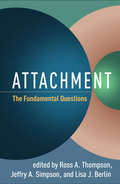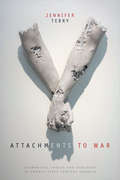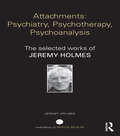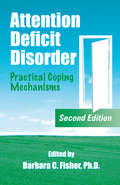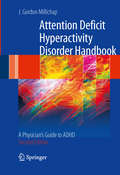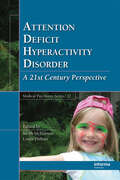- Table View
- List View
Atrial Fibrillation: From Bench to Bedside (Contemporary Cardiology #Volume 92-1)
by Jose Jalife Andrea NataleThis important new book presents advancements in the treatment and prevention of Atrial Fibrillation (AF). The reader is provided with the latest information that is critically important in the daily care and for the potential cure of patients with AF. Each chapter deals with a different aspect of AF and each chapter is authored by internationally recognized experts in the evolving field of cardiac electrophysiology. This book is a single source that provides a multi-perspective look at and approach to AF. Because AF is so prevalent and affects all areas of medicine, the information in this book will be useful to all those in the medical field.
Atrial Septal Defects: Diagnosis and Management
by Ajith Ananthakrishna Pillai Vidhyakar BalasubramanianThis comprehensive text follows an evidence-based approach to thoroughly discuss Atrial septal defects. Since this congenital heart disease mostly presents in adulthood, it becomes imperative to understand the embryology, pathophysiology and anatomy in detail, for effective management of these patients. This book has strong clinical focus on anatomy, natural history, indications, imaging methods and practical aspects of disease management, which inculcates best practice in the day to day management techniques employed by cardiologists, trainees and professionals. Key Features Covers all aspects of atrial septal defects with a logical flow of topics. Serves as a useful guide to clinical cardiologists aiming to specialize in atrial septal defects and professionals entering the field. Explores future directions in diagnosis and treatment, elaborating on the use of 3D echocardiography and Intracardiac echocardiography.
Atrophic Rhinitis: From the Voluptuary Nasal Pathology to the Empty Nose Syndrome
by Stefano Di GirolamoThis book presents the state of the art in atrophic rhinitis and analyses its specific characteristics in non-allergic rhinitis. Little has been written on this condition, which represents a topical issue in modern clinical practice, and as such many clinicians tend to underestimate its impact on patients’ quality of life. This book covers the definition, aetiology, clinical presentation, diagnosis and management, providing specialists with a better understanding of this condition and of the treatment options. It describes in detail the latest diagnostic tools, such as the innovative computational fluid-dynamics studies, nasal cytology, trigeminal stimulation tests, olfactometry, subjective questionnaires, with a focus on the psychological aspects, which have not yet been systematically investigated. Further, it discusses therapeutic strategies, both medical and surgical, reviewing the literature, from the first historical procedures to recent conservative techniques, such as lateral nasal wall reconstruction with various materials, and septal perforation repair. Illustrating all the options currently available, the book is an invaluable resource, not only for otolaryngologists, but also for plastic surgeons, clinical allergists and rheumatologists.
Att Överleva Schizofreni
by Richard Carlson Jr. Berenice Arrieta CortésRichard Carlson Jr. diagnostiserades med paranoid schizofreni när han var tjugo år gammal. Hans sjukdom först manifesterade när han var en ung ungdom. Modern psykiatri misslyckades starkt Richard för över ett decennium. Därefter förstod han, efter en incident som involverade polisen, att hans diagnos var riktig och började äntligen den långa processen att återhämta sig. Över tio år senare förbättras hans liv väsentligt. Under sin behandling återhämtade sig också Richard från depression, tvångssyndrom och slöhet. Låt inte vad som hände med Richard hända dig, en nära anhörig, eller en patient som arbetar med allvarlig psykisk sjukdom. Alltid vara ärliga med varandra, och med din psykiater.
Attachment Narrative Therapy: Applications In A Range Of Clinical Settings (Palgrave Texts in Counselling and Psychotherapy Series)
by Rudi DallosThis textbook provides an up-to-date guide to the application of Attachment Narrative Therapy (ANT), a model that combines concepts and techniques from systemic family therapy, narrative therapy and theory and attachment theory. Edited and with contributions from leading practitioners of ANT, this book brings together illustrations of its applications in a variety of clinical settings. It offers practical guidance and the latest research from clinicians who are now advancing its application. Another important feature is illustration of how practitioners have developed ANT to incorporate the latest ideas and methods from trauma theory and neuro-biology. It will provide a valuable new resource for practitioners, teachers and students of systemic practice, family therapy, clinical psychology, counselling and psychotherapy.
Attachment Processes in Couple and Family Therapy
by Susan Johnson Valerie WhiffenThis practical book presents cutting-edge approaches to couple and family therapy that use attachment theory as the basis for new clinical understandings. Fresh and provocative insights are provided on the nature of interactions between adult partners and among parents and children; the role of attachment in distressed and satisfying relationships; and the ways attachment-oriented interventions can address individual problems as well as marital conflict and difficult family transitions. With contributions from leading clinicians and researchers, the volume offers both general strategies and specific techniques for helping clients build stronger, more supportive relational bonds.
Attachment Theory and Research
by Jeffry A. Simpson W. Steven RholesThis volume showcases the latest theoretical and empirical work from some of the top scholars in attachment. Extending classic themes and describing important new applications, the book examines several ways in which attachment processes help explain how people think, feel, and behave in different situations and at different stages in the life cycle. Topics include the effects of early experiences on adult relationships; new developments in neuroscience and genetics; attachment orientations and parenting; connections between attachment and psychopathology, as well as health outcomes; and the relationship of attachment theory and processes to clinical interventions.
Attachment Theory and Research in Clinical Work with Adults
by Ety Berant Joseph ObegiWritten with the practicing psychotherapist in mind, this invaluable book presents cutting-edge knowledge on adult attachment and explores the implications for day-to-day clinical practice. Leading experts illustrate how theory and research in this dynamic area can inform assessment, case formulation, and clinical decision making. The book puts such concepts as the secure base, mentalization, and attachment styles in a new light by focusing on their utility for understanding the therapeutic relationship and processes of change. It offers recommendations for incorporating attachment ideas and tools into specific treatment approaches, with separate chapters on psychoanalytic, interpersonal, cognitive-behavioral, and emotionally focused therapies.
Attachment Theory in Clinical Work with Children
by David Oppenheim Douglas GoldsmithAttachment research has tremendous potential for helping clinicians understand what happens when parent-child bonds are disrupted, and what can be done to help. Yet there remains a large gap between theory and practice in this area. This book reviews what is known about attachment and translates it into practical guidelines for therapeutic work. Leading scientist-practitioners present innovative strategies for assessing and intervening in parent-child relationship problems; helping young children recover from maltreatment or trauma; and promoting healthy development in adoptive and foster families. Detailed case material in every chapter illustrates the applications of research-based concepts and tools in real-world clinical practice.
Attachment Theory in Practice: Emotionally Focused Therapy (EFT) with Individuals, Couples, and Families
by Susan M. JohnsonDrawing on cutting-edge research on adult attachment--and providing an innovative roadmap for clinical practice--Susan M. Johnson argues that psychotherapy is most effective when it focuses on the healing power of emotional connection. The primary developer of emotionally focused therapy (EFT) for couples, Johnson now extends her attachment-based approach to individuals and families. The volume shows how EFT aligns perfectly with attachment theory as it provides proven techniques for treating anxiety, depression, and relationship problems. Each modality (individual, couple, and family therapy) is covered in paired chapters that respectively introduce key concepts and present an in-depth case example. Special features include instructive end-of-chapter exercises and reflection questions.
Attachment and Psychoanalysis
by Morris N. EagleAlthough attachment theory was originally rooted in psychoanalysis, the two areas have since developed quite independently. This incisive book explores ways in which attachment theory and psychoanalysis have each contributed to understanding key aspects of psychological functioning--including infantile and adult sexuality, aggression, psychopathology, and psychotherapeutic change--and what the two fields can learn from each other. Morris Eagle critically evaluates how psychoanalytic thinking can aid in expanding core attachment concepts, such as the internal working model, and how knowledge about attachment can inform clinical practice and enrich psychoanalytic theory building.
Attachment in Adulthood
by Phillip Shaver Mario MikulincerThis authoritative work provides a systematic, comprehensive overview of theory and research on adult attachment. The authors who have been at the forefront of this rapidly growing field since the concepts of "adult attachment" and "attachment style" were first developed trace how Bowlby and Ainsworth's original constructs have evolved through the study of adolescents and adults. They review extant measures and analyze how attachment theory has been used to advance scientific understanding of emotions, social cognition, close relationships, psychopathology, and psychotherapy.
Attachment in Adulthood
by Phillip R. Shaver Mario MikulincerThis authoritative work provides a systematic, comprehensive overview of theory and research on adult attachment. The authors-who have been at the forefront of this rapidly growing field since the concepts of "adult attachment" and "attachment style" were first developed-trace how Bowlby and Ainsworth's original constructs have evolved through the study of adolescents and adults. They review extant measures and analyze how attachment theory has been used to advance scientific understanding of emotions, social cognition, close relationships, psychopathology, and psychotherapy.
Attachment in Adulthood, Second Edition: Structure, Dynamics, and Change
by Phillip R. Shaver Mario MikulincerSynthesizing a vast body of empirical research and organizing it around a comprehensive conceptual model, this book is recognized as the definitive reference on adult attachment. The authors explain how what began as a theory of child development is now used to conceptualize and study nearly all aspects of social functioning across the lifespan, including mental representations of self and others, emotion regulation, personal goals and strivings, couple relationships, caregiving, sexuality, psychopathology, psychotherapy, and organizational behavior. The origins and measurement of individual differences in adult attachment are examined, as is the question of whether and how attachment patterns can change. New to This Edition: *Reflects major advances, including hundreds of new studies. *Clarifies and extends the authors' influential model of attachment-system functioning. *Cutting-edge content on genetics and on the neural and hormonal substrates of attachment. *Increased attention to the interplay among attachment and other behavioral systems, such as caregiving and sexuality. *Expanded discussion of attachment processes in counseling and psychotherapy. *Additional coverage of leadership, group dynamics, and religion.
Attachment in Psychotherapy
by David J. WallinThis eloquent book translates attachment theory and research into an innovative framework that grounds adult psychotherapy in the facts of childhood development. Advancing a model of treatment as transformation through relationship, the author integrates attachment theory with neuroscience, trauma studies, relational psychotherapy, and the psychology of mindfulness. Vivid case material illustrates how therapists can tailor interventions to fit the attachment needs of their patients, thus helping them to generate the internalized secure base for which their early relationships provided no foundation. Demonstrating the clinical uses of a focus on nonverbal interaction, the book describes powerful techniques for working with the emotional responses and bodily experiences of patient and therapist alike.
Attachment in Psychotherapy
by Susan Johnson David WallinThis eloquent book translates attachment theory and research into an innovative framework that grounds adult psychotherapy in the facts of childhood development. Advancing a model of treatment as transformation through relationship, the author integrates attachment theory with neuroscience, trauma studies, relational psychotherapy, and the psychology of mindfulness. Vivid case material illustrates how therapists can tailor interventions to fit the attachment needs of their patients, thus helping them to generate the internalized secure base for which their early relationships provided no foundation. Demonstrating the clinical uses of a focus on nonverbal interaction, the book describes powerful techniques for working with the emotional responses and bodily experiences of patient and therapist alike.
Attachment-Informed Parent Coaching
by Beth TroutmanThis book examines attachment-informed parent coaching to address emotional and behavioral problems of young children. The volume summarizes relevant developmental and attachment theory research and describes how it supports an attachment-informed parent coaching approach. The book addresses the challenges of parenting young children with disruptive behavior or who are emotionally reactive, and how mental health providers can help parents address these challenges. Chapters describe how therapists can use their observations of parents and children interacting to tailor parent coaching according to different child and adult attachment patterns. It discusses the important role of adult attachment in tailoring parent coaching, including an understanding of how the therapist’s working model of attachment influences their work with families. Each chapter includes information on current research as well as rich examples of how this research can inform clinical practice. Key areas of coverage include: The role of adult attachment in working with young children. Addressing secure, ambivalent/resistant, avoidant, disorganized, and controlling child-parent dyads. Coaching parents who have a secure, earned secure, preoccupied, dismissing, or unresolved working model of attachment. Working with adopted children and children in foster care. This book is an essential resource for researchers, professors, and graduate students as well as clinicians and professionals in developmental psychology, social work, pediatrics, family studies, nursing, child psychiatry, pediatrics, occupational therapy, and early childhood education.
Attachment: The Fundamental Questions
by Ross A. Thompson, Jeffry A. Simpson, Lisa J. BerlinThe ongoing growth of attachment research has given rise to new perspectives on classic theoretical questions as well as fruitful new debates. This unique book identifies nine central questions facing the field and invites leading authorities to address them in 46 succinct essays. Multiple perspectives are presented on what constitutes an attachment relationship, the best ways to measure attachment security, how internal working models operate, the importance of early attachment relationships for later behavior, challenges in cross-cultural research, how attachment-based interventions work, and more. The concluding chapter by the editors delineates points of convergence and divergence among the contributions and distills important implications for future theory and research.
Attachments to War: Biomedical Logics and Violence in Twenty-First-Century America
by Jennifer TerryIn Attachments to War Jennifer Terry traces how biomedical logics entangle Americans in a perpetual state of war. Focusing on the Afghanistan and Iraq wars between 2002 and 2014, Terry identifies the presence of a biomedicine-war nexus in which new forms of wounding provoke the continual development of complex treatment, rehabilitation, and prosthetic technologies. At the same time, the U.S. military rationalizes violence and military occupation as necessary conditions for advancing medical knowledge and saving lives. Terry examines the treatment of war-generated polytrauma, postinjury bionic prosthetics design, and the development of defenses against infectious pathogens, showing how the interdependence between war and biomedicine is interwoven with neoliberal ideals of freedom, democracy, and prosperity. She also outlines the ways in which military-sponsored biomedicine relies on racialized logics that devalue the lives of Afghan and Iraqi citizens and U.S. veterans of color. Uncovering the mechanisms that attach all Americans to war and highlighting their embeddedness and institutionalization in everyday life via the government, media, biotechnology, finance, and higher education, Terry helps lay the foundation for a more meaningful opposition to war.
Attachments: The selected works of Jeremy Holmes (World Library of Mental Health)
by Jeremy HolmesFor three decades Jeremy Holmes has been a leading figure in psychodynamic psychiatry in the UK and across the world. He has played a central role in promoting the ideas of John Bowlby and in developing the clinical applications – psychiatric and psychotherapeutic – of Attachment Theory in working with adults. Drawing on both psychoanalytic and attachment ideas, Holmes has been able to encompass a truly biopsychosocial perspective. As a psychotherapist Holmes brings together psychodynamic, systemic and cognitive models, alert to vital differences, but also keenly sensitive to overlaps and parallels. This volume of selected papers brings together the astonishing range of Holmes' interests and contributions. The various sections in the book cover: An extended interview – covering Holmes’ career and philosophy as a psychodynamic psychiatrist 'Juvenilia' – sibling relationships, the psychology of nuclear weapons, and the psychodynamics of surgical intervention. Psychodynamic psychiatry: Integrative and Attachment-Informed A psychotherapy section in which he develops his model of psychotherapeutic change 'Heroes' – biographical pieces about the major influences including, John Bowlby, Michael Balint, David Malan, Jonathan Pedder and Charles Rycroft. 'Ephemera' – brief pieces covering such topics as frequency of psychodynamic sessions and fees. Attachments: Psychiatry, Psychotherapy, Psychoanalysis - The Selected Works of Jeremy Holmes will be essential and illuminating reading for practitioners and students of psychiatry and psychotherapy in all its guises.
Attending: Medicine, Mindfulness, and Humanity
by Dr Ronald EpsteinThe first book for the general public about mindfulness and medical practice, a groundbreaking, intimate exploration of how doctors think and what matters most—safe, effective, patient-centered, compassionate care—from the foremost expert in the field.As a third-year Harvard Medical School student doing a clinical rotation in surgery, Ronald Epstein watched an error unfold: an experienced surgeon failed to notice his patient’s kidney turning an ominous shade of blue. In that same rotation, Epstein was awestruck by another surgeon’s ability to avert an impending disaster, slowing down from autopilot to intentionality. The difference between these two doctors left a lasting impression on Epstein and set the stage for his life’s work—to identify the qualities and habits that distinguish masterful doctors from those who are merely competent. The secret, he learned, was mindfulness. In Attending, his first book, Dr. Epstein builds on his world-renowned, innovative programs in mindful practice and uses gripping and deeply human clinical stories to give patients a language to describe what they value most in health care and to outline a road map for doctors and other health care professionals to refocus their approach to medicine. Drawing on his clinical experiences and current research, and exploring four foundations of mindfulness—Attention, Curiosity, Beginner’s Mind, and Presence—Dr. Epstein introduces a revolutionary concept: by looking inward, health care practitioners can grow their capacity to provide high-quality care and the resilience to be there when their patients need them. The commodification of health care has shifted doctors’ focus away from the healing of patients to the bottom line. Clinician burnout is at an all-time high. Attending is the antidote. With compassion and intelligence, Epstein offers a crucial, timely book that shows us how we can restore humanity to medicine, guides us toward a better overall quality of care, and reminds us of what matters most.
Attention Deficit Disorder: Practical Coping Mechanisms
by Lisa V. BlitzCompletely revised and updated, this Second Edition spans every issue related to ADD care and treatment. New chapters focus on emerging issues, the overlap of sleep disorders, how sleep disorders mimic ADD/ADHD and/or increase the symptoms, ADHD and sleep apnea, ADHD and restless legs or periodic limb movements in sleep, sleep in children, adolesce
Attention Deficit Hyperactivity Disorder
by Stephen M. Stahl Nancy Muntner Laurence MignonAs with Stahl's Essential Psychopharmacology, 3rd edition and The Prescriber's Guide, Attention Deficit Hyperactivity Disorder is a heavily illustrated title with a fun approach to theories. Stahl has been at the heart of significant advances in the treatment of ADHD in the past ten years, as new psychopharmacologic medications and cognitive and behavioral therapy techniques have been introduced into practice. The visual learner will find that these books make psychopharmacology concepts easy to master, while the non-visual learner will enjoy a shortened text version of complex psychopharmacology concepts. Novices to the series will find that the well-structured graphics and visual vocabulary can help build a vivid conception of complex pharmacologies. The complementary tables and algorithms provide clinical strategies and tips for drug dosaging, and the Suggested Reading section at the end of each book is an invaluable tool to guide the reader to more in-depth learning on particular concepts.
Attention Deficit Hyperactivity Disorder Handbook: A Physician's Guide to ADHD
by J. Gordon MillichapAn expanded, updated, and revised edition, the ADHD Handbook, second edition covers recent advances in causes and management of ADHD, and includes more than 400 scientific references to peer-reviewed articles. It provides answers to the numerous questions that surround ADHD, including how is it diagnosed? What causes ADHD? What are the risks of associated learning and behavior disorders, tics, seizures, and headaches? What treatments are available? What are the choices of medications and the risks of side effects? How can adverse effects be avoided? What are the alternatives to medication? Do children outgrow ADHD, and how long is treatment required? ADHD Handbook is written for neurologists, pediatricians, practicing physicians, residents, fellows and students of medicine, psychologists, educators, occupational and speech therapists, nurse practitioners and other healthcare providers. It also offers parents a readable, but uniquely well documented and objective account of ADHD symptoms, diagnosis, medications, alternative treatments, and management.
Attention Deficit Hyperactivity Disorder: Concepts, Controversies, New Directions (Medical Psychiatry Series)
by Keith McBurnett Linda PfiffnerCompiling the expertise and research of many of the most widely-cited opinion leaders in the field, this reference spans the etiology, assessment, and management of ADHD and covers all the essential data required to care for patients with this disorder including clinical definitions, psychosocial management approaches, medication dosing ranges, and
